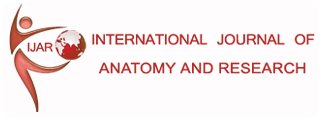IJAR.2017.187
Type of Article: Original Research
Volume 5; Issue 2.2 (May 2017)
Page No.: 3809-3812
DOI: https://dx.doi.org/10.16965/ijar.2017.187
EMBALMING FLUID- A POISONOUS PRESERVATION POTION: EFFECTS ON PULMONARY FUNCTIONS OF STUDENTS
Rashmi Malhotra *1, Rajesh Kathrotia 2, Arun Goel 2, Yogesh Singh 2.
*1 Department of Anatomy, All India Institute of Medical Sciences, Rishikesh, India.
2 Department of Physiology, All India Institute of Medical Sciences, Rishikesh, India.
Corresponding Author: Dr. Rashmi Malhotra, Assistant Professor, department of Anatomy, All India Institute of Medical Sciences, Rishikesh – 249 203, India. E-Mail: rashmimalhotraaiimsr@gmail.com
ABSTRACT
Objective: To explore the effects of acute exposure of embalming fluid fumes on the pulmonary functions in first year medical students.
Materials and Methods: The present study was carried out on 40 healthy, non- smoker first year medical students. The participants were exposed to embalming fluid fumes during cadaver dissection for duration of two hours. Pulmonary Function Tests (PFTs) were performed with computerized spirometer, prior to and immediately after the exposure. The outcome measures were Vital capacity (VC), Forced expiratory volume in 1 second (FEV1), FEV1/ FVC ratio, Peak Expiratory Flow Rate (PEFR), FEF25-75% and subjective symptoms reported by participants.
Results: The acute exposure of embalming fluid fumes was associated with significant decrease in FEV1/FVC ratio and FEF25-75%. Rest of the respiratory parameters did not show significant changes. The chief subjective complaints of the participants were pungent smell (92%), throat congestion (72%), burning sensation in eye (70%), headache (60%), nausea (52%) and rhinorrhoea (45%).
Conclusion: The acute exposure to fumes of embalming fluid during cadaver dissection was suggestive of respiratory function dysfunction at the level of mid-airway obstruction and mucosal irritation.
Key words: Embalming fluid fumes, FEV1/FVC ratio, FEF25-75%.
REFERENCES
- Brenner E. Human Body Preservation – Old and New Techniques. J. Anat 2014; 224:316- 344.
- Mysorekar VR, Zargar RK, Singh H. Embalming and Preservation of Cadavers: An All-India Survey. J Anat Soc India 1997; 26(3): 149-155.
- Ajmani ML. Embalming Principals and Legal Aspects. 1st New Delhi, India: Jaypee Brothers Medical Publishers (P) Ltd. 1998:116-117.
- Gichner T.IARC monographs on the evaluation of carcinogenic risks to humans. Wood dust and formaldehyde. Lyon, International Agency for Research on Cancer 1995; 6:217-362.
- Dixit D, Athavia PD, Pathak HM. Toxic effects of embalming fluid on medical students and professionals. JIAFM 2005; 27(4):209-211.
- Berbstein, RS, Staynedr LT, Elliott LJ, Kimbrough R. Inhalation exposure to formaldehyde: An overview of its toxicology, epidemiology, monitoring and control. Ind. Hyg. Assoc. J 1984; 45:778-85.
- Burge PS, Harries MG, Lam WK, O´Brien IM, Patchett PA. Occupational asthma due to formaldehyde 1985; Thorax; 40:255-60.
- Shusterman D. The effects of Air Pollutants and Irritants on the Upper Airway. Proc Am Thorac Soc 2011; 8 :101-105.
- Lambert A, Drummond MB, Wei C, Irvin C, Kaminsky D, McCormack M, Wise R. Diagnostic accuracy of FEV1/forced vital capacity ratio z scores in asthmatic patients. J Allergy Clin Immunol 2015 Sep; 136(3):649-653.
- Goel A, Goyal M, Singh R, Verma N, Tiwari S. Diurnal Variation in Peak Expiratory Flow and Forced Expiratory Volume. Journal of Clinical and Diagnostic Research 2015; 9(10):CC05-CC07.
- Chia SE, Ong CN, Foo SC, Lee HP. Medical students’ exposure to formaldehyde in a gross anatomy dissection laboratory. J Am Coll Health 1992; 41(3):115-9.
- Khaliq F, Tripathi P. Acute effects of formalin on pulmonary functions in gross anatomy laboratory. Indian J Physiol Pharmacol 2009; 53(1):93-6.
- Binawara BK, Rajnee, Choudhary S, Mathur KC, Sharma H, Goyal K. Acute effect of formalin on pulmonary function tests in medical students. Pak J Physiol 2010; 6(2):8-10.
- Akbar-Khanzadeh F, Mlynek JS. Changes in respiratory function after one and three hours of exposure to formaldehyde in non-smoking subjects. Occup Environ Med 1997; 54(5):296–300.
- Sauder LR, Green DJ, Chalham MD, Kulle TJ. Acute pulmonary response of asthmatics to 3.0 ppm formaldehyde Toxical Ind Health. 1987; 3:569–57.
- Kurose T, Kodera H, Aoyama H, Kawamata S. Formaldehyde concentration in the air and in cadavers at the gross anatomy laboratory in Hiroshima University. Hiroshima J Med Sci 2004; 53: 33-7.
- Schachter EN, Witek TJ Jr, Tosun T, Leaderer BP, Beck GJ. A study of respiratory effects from exposure to 2 ppm formaldehyde in healthy subjects. Arch Environ Health 1986; 41: 229- 239.
- Gurburz N, Coskun Z K, Liman F A, Anil A, Turgut H B. The Evaluation of Formaldehyde Exposure in the Anatomy Laboratories and the Preventive Measures. GMJ 2016; 27:98-103.
- Zenz C, Dickerson OB, Horvath E.P. Occupational Medicine. 3rd Edi, St. Louis 1994; MO: 106.
- Ohmichi, K, Komiyama M, Matsuno Y, Takanashi, Y, Miyamoto H, Kadot T, Maekawa M,Toyama, Y, Tatsugi Y, Kohno T, Ohmichi M, Mori, C. Formaldehyde exposure in a gross anatomy laboratory-personal exposure level is higher than indoor concentration. Sci. Pollut. Res. Int 2006; 13(2):120-4.
- Formaldehyde, 2-Butoxyethanol and 1-tert-Butoxypropan-2- ol, IARC Monographs on the Evaluation of Carcinogenic Risks to Humans, Lyon, France: International Agency for Research on Cancer 2006; 88:39–325.








